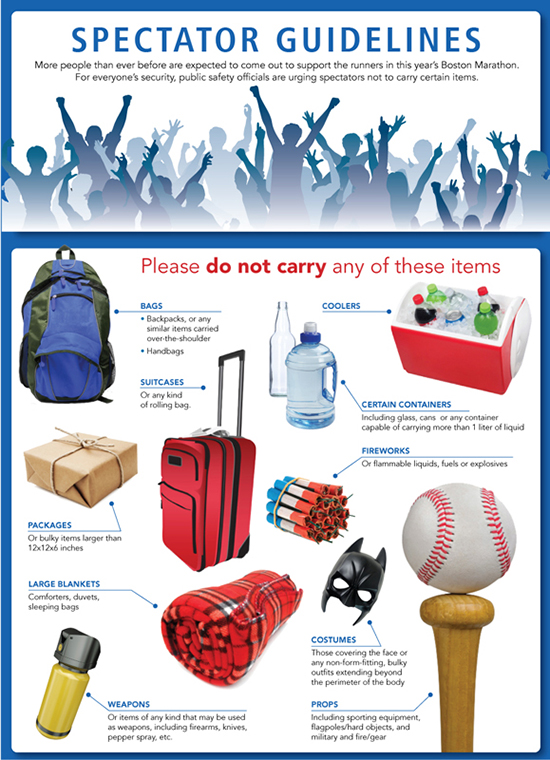Recent Terrorism Informs Security for Boston Marathon
No drones, backpacks, coolers, large bags, or blankets

Among the items Boston Marathon officials want spectators to leave at home for Monday’s annual race are drones, backpacks, and glass containers. Photo courtesy of Flickr contributor Sonia Su
The Federal Bureau of Investigation, informed by recent terrorist attacks in Paris, San Bernardino, Calif., and Brussels, has put in place a series of security measures to prevent a similar attack during Monday’s Boston Marathon.
The FBI did not detail those measures in its announcement earlier this month. The bureau said there have been no credible threats against the Marathon, but that officials are preparing for what they don’t know.
In addition, police have established a “no-drone zone” along the race route and are asking spectators and runners to leave those aerial video devices at home.
Otherwise, “most of the security aspects of the Marathon are similar to what we experienced last year,” says BU Police Captain Robert Molloy. Security was fortified after the 2013 bombings that killed three, among them graduate student Lu Lingzi (GRS’13), and injured more than 260.
As with last year, race officials ask spectators not to bring backpacks, shoulder bags, blankets, larger packages, coolers, glass containers, and some other items with them. Find a full list of such items here.
“Spectators approaching viewing areas on the course, or in viewing areas on the course, may be asked to pass through security checkpoints, and law enforcement officers or contracted private security personnel may ask to inspect bags and other items being carried,” according to the Massachusetts Emergency Management Agency (MEMA). The agency encourages bystanders to carry permissible personal items in a clear plastic bag to “enhance public safety and speed security screening.” MEMA also offers Massachusetts Alerts, a free, downloadable app for Android and iPhones—runners’ and spectators’—that can receive emergency and public safety information. Find information about the app here.
As in recent years, “bandits,” or unauthorized, unregistered runners, are not permitted to join the race and will be stopped by security personnel.
Almost 5,000 law enforcement officers will be deployed along the 26.2-mile course, including about 15 from the BUPD, which is primarily assigned to secure the area around Audubon Circle. “That has the greatest concentration of BU students” watching the race, Molloy says. As they did last year, University officers will join their Boston and Brookline counterparts in bicycle and motorcycle units.
Because the Marathon is run on Patriots Day, a state holiday, BU’s normal parking and transportation procedures will be on a special schedule. The BUS (BU Shuttle) will not operate its daytime service and will resume after 10 p.m., with the late night schedule. BU’s permit parking lots will be open, as will its pay-on-entry lots and garages at Agganis Arena, Warren Towers, Granby (665 Commonwealth Ave.), and 766 Commonwealth Ave. The Massachusetts Bay Transportation Authority (MBTA) Copley station will be closed the entire day, and the Green Line B branch South Street stop and C branch Kent Street and St. Mary’s Street stops will be closed between 10 a.m. and approximately 6 p.m. The #57 Bus will be in service, but inbound service will end at St. Paul Street and outbound service will not operate between Kenmore Square and Buick Street. Bicycles are banned from MBTA trains and buses on Monday.
Molloy says his best advice for students who want to watch the Marathon from the sidelines (it will be televised live locally on CBS affiliate WBZ-TV) is to observe the restricted-items list, and to observe, period: “If something looks suspicious, if something looks out of place, please call the Boston University police or 911.” The BUPD’s immediate response number is 617-353-2121.
In a Boston Globe interview after last month’s attacks in Brussels, William Evans, Boston police commissioner, outlined security steps taken since the 2013 Marathon bombings: “We have more cameras out there. We have more tactical units. Officers are undercover working the crowd. We’re constantly monitoring events as they play out, not only across the country, but internationally. We’re going to be on our toes watching for any intelligence that might lead us to someone who might try to jeopardize the Marathon.”
In advance of the race, today, from noon until 4 p.m., student volunteers from Student Health Services (SHS) will distribute information about safe drinking strategies at the George Sherman Union and outside the West Campus dining hall. The tips range from intervening to help an intoxicated peer to strategies for safe consumption.
“We know that some students choose to celebrate Marathon Monday by drinking,” says Katharine Mooney (SPH’12), director of SHS Wellness & Prevention Services. “It’s important to share alcohol safety information with these students and others who aren’t drinking, so that everyone is well informed about resources if they see someone they’re concerned about.”
A BU scholarship fund in Lu Lingzi’s memory has raised more than $1 million in gifts and pledges to support international graduate students; contributions may be made here. The Boston University Chinese Students & Scholars Association will sponsor a photo exhibition and silent auction to benefit the fund on Thursday, April 21, from noon until 7 p.m., at the BU Alley in the George Sherman Union basement. Photos, most by BU students, will be auctioned off (the mandatory minimum bid is $15).
The city also will observe its second annual One Boston Day today, April 15, commemorating community response to the April 15, 2013, bombings. The day features philanthropic activities by businesses and nonprofits.


Comments & Discussion
Boston University moderates comments to facilitate an informed, substantive, civil conversation. Abusive, profane, self-promotional, misleading, incoherent or off-topic comments will be rejected. Moderators are staffed during regular business hours (EST) and can only accept comments written in English. Statistics or facts must include a citation or a link to the citation.